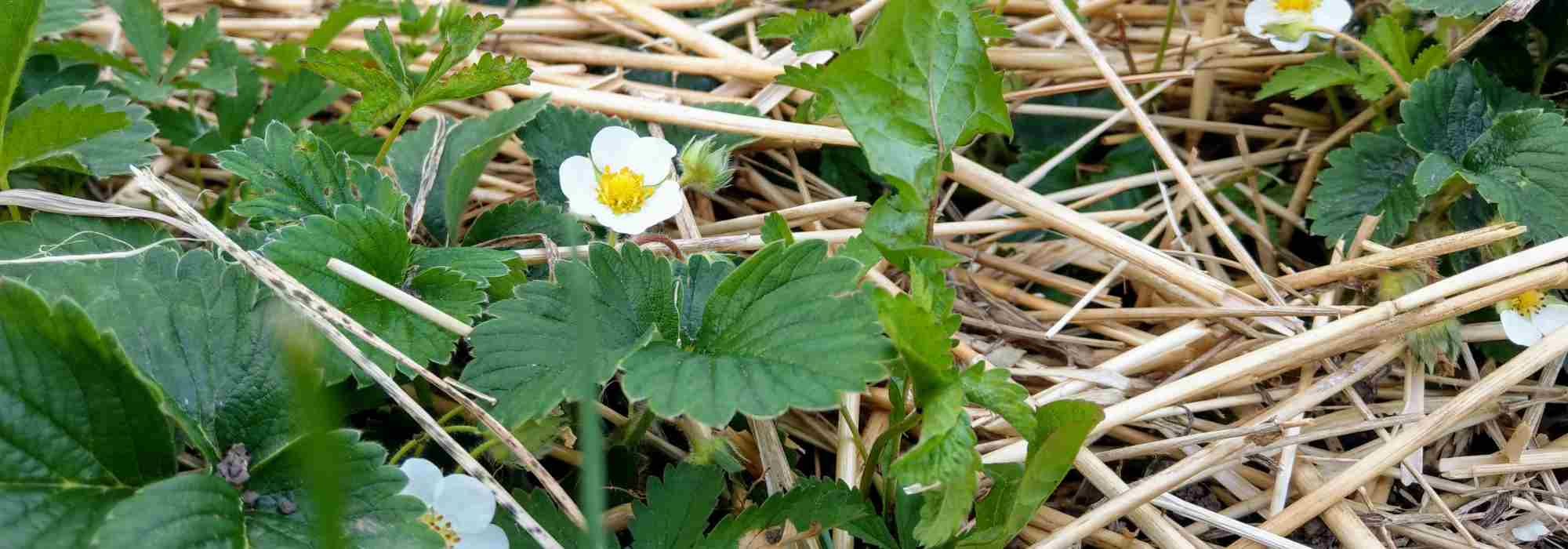
Which mulch to choose for strawberry plants?
Everything you must know on natural mulches for strawberries
Contents
Strawberry plants grown in the vegetable garden, or even in containers on a balcony, need mulching to retain moisture during the summer months and to reduce weeds. The best time to mulch strawberries is after the soil has warmed sufficiently, when growth resumes vigorously, usually around mid-April. Applied in spring, when establishing or replanting your strawberry bed, there are several types of organic mulch, each with its own advantages and disadvantages.
From grass clippings to planting felt, whether sourced from your garden or purchased commercially, we sift through them to help you choose the best mulch for your strawberry plants.
Straw
Undoubtedly the most widely used mulch in vegetable gardens for generations.
And for good reason, straw has many advantages: it is lightweight, easy to handle and economical, and it effectively protects delicate small fruits like strawberries from dirt and soil splashes caused by heavy rain. It helps reduce the risk of fungal diseases. Moreover, it does a fairly good job of suppressing weed growth.
- Its effects on soil moisture: Straw is an excellent insulator that keeps the soil cool and moist. It does not create moisture but retains it, especially if applied in late morning on already damp soil.
- Its drawbacks regarding pests and diseases: It can attract slugs more easily (and even snakes if you live in the countryside!) if applied in too thick a layer.
- Minor downsides: It may cause nitrogen deficiency, as it is rich in carbon (high C/N ratio). It is harder to find in urban areas, so be sure to use non-seeded straw, and it may contain weed seeds if not clean.
Quantity to use and mulch renewal
Apply a layer 5 to 10 cm thick—not too much, not too little, as thicker mulch retains more moisture and may attract rodents. Straw decomposes quickly, requiring frequent renewal, often annually.
⊕ Our opinion: Straw remains a classic choice and is perfectly suited for large strawberry beds in the vegetable garden. Ideally, use it mixed with grass clippings to limit nitrogen deficiency.
N.B.: Hay can also be used, but it is richer and decomposes faster than straw, with a higher risk of containing weed seeds.
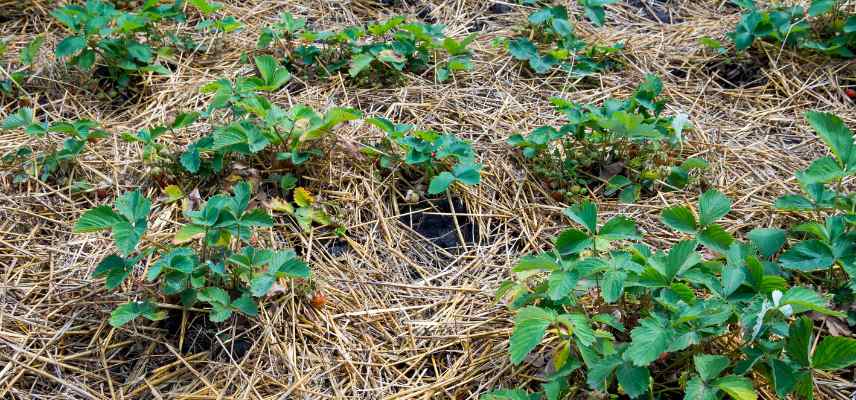
Grass clippings
Another little treasure is within reach throughout the growing season when we mow the lawn. Collecting grass clippings and letting them dry makes for an effective, natural mulch… and so practical!
Fresh grass clippings are rich in nitrogen, particularly useful at the start of cultivation, and effectively complement drier mulches like straw. When spread in thin layers, clippings efficiently suppress weeds while gradually enriching the soil as they decompose. They also provide good thermal insulation and help retain soil moisture.
- Effects on soil moisture: grass clippings retain soil moisture very well, especially when applied to already damp soil. By forming a dense layer, they reduce evaporation, which is helpful during hot or windy periods.
- Drawbacks regarding diseases/pests: if applied too thickly or when too fresh, clippings can ferment and attract slugs. They create a warm, humid environment that may encourage fungal diseases, particularly during frequent rainfall.
- Minor downsides: cut grass decomposes quickly and thus needs frequent replenishment. Additionally, it should only come from lawns untreated with chemicals.
Quantity to use and mulch renewal
Apply regularly in thin successive layers during spring: spread clippings in thin layers of 2-3 cm maximum, slightly dried beforehand, as they ferment quickly, generate heat, suffocate the soil, or attract slugs if left damp on the surface. It’s best to let them dry slightly for a few hours in the sun before spreading. Replenish every two to three weeks in spring… or whenever you mow.
⊕ Our opinion : grass clippings make excellent short-term mulch, especially early in the season or when combined with a drier mulch like straw or wood chips. They stimulate the soil and prevent nitrogen deficiency but require slightly more careful application.
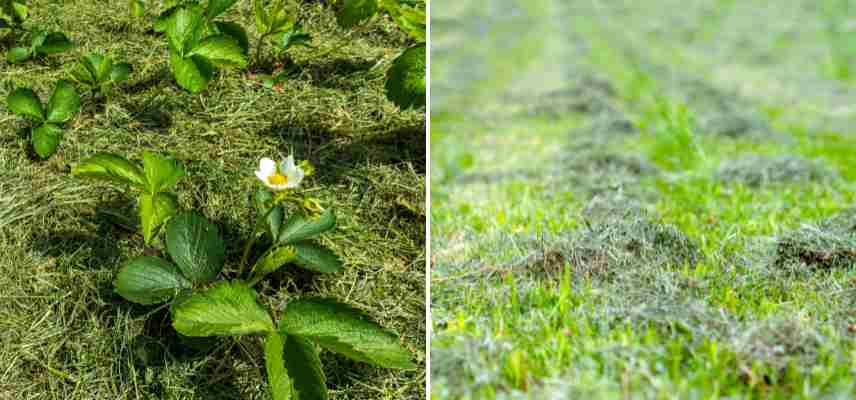
RCW (ramial chipped wood)
We often talk about it for mulching shrub beds, RCW (ramial chipped wood) or BRF in French is a wood chip made from shredded young branches. It can be used for strawberry plants, as the wood chips mimic their natural environment, since strawberries originally grew as woodland plants. RCW suppresses weeds quite effectively while also improving soil aeration. Being biodegradable, it enhances soil structure in the long term and enriches it. It can therefore be considered for other crops besides strawberries.
- Effects on soil moisture: RCW forms an effective barrier against water evaporation. It helps the soil retain moisture while promoting the formation of stable humus over time. It is particularly useful for strawberry plants in summer or during dry spells.
- Drawbacks regarding diseases/pests: it does not attract slugs much. Although it does not directly encourage diseases, RCW may temporarily imbalance the soil (particularly the carbon/nitrogen ratio) and thus weaken young plants if used alone on poor soil.
- Minor drawbacks : it may cause nitrogen deficiency in the first few weeks. It should therefore be combined with good homemade compost or grass clippings to counteract this effect. It remains costly if not produced at home using a shredder. Avoid using it immediately after planting or on newly planted strawberry beds.
Quantity to use and mulch renewal
Spread a layer of 4 to 6 cm between strawberry rows, ideally in autumn or early spring. It decomposes slowly and can last 2 to 3 seasons.
⊕ Our opinion: RCW is an excellent mulch for well-established strawberry beds. It improves soil structure and retains moisture effectively, provided it is combined with a nitrogen source initially (grass clippings, compost or manure). Slow to decompose, it is ideal for weekend gardeners who have little time to dedicate to their vegetable patches. And if you have nothing else on hand, it does the job perfectly!
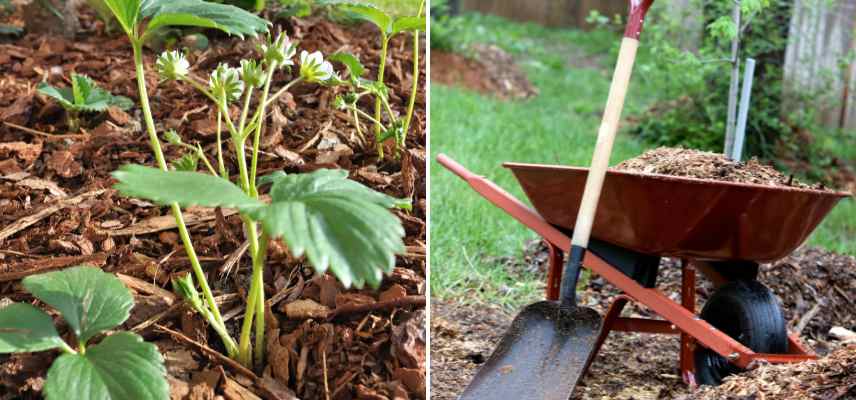
Hemp, miscanthus or flax mulches
These mulches are now readily available in stores. They come in the form of pale flakes. These ready-to-use organic mulches are increasingly popular for their effectiveness, aesthetic appeal, and durability. Sourced from agricultural crops or recycled fibres, they are biodegradable and easy to apply. These mulches are particularly recommended for heavy soil, as they improve its structure in the long term, reduce crusting, and stimulate soil life. They are also beneficial in regions with high rainfall.
- Their effects on soil moisture: highly effective at maintaining good humidity levels, these mulches create a light, airy barrier that protects the soil from drying out. Flax is particularly absorbent, while hemp also retains coolness well. It is advisable to water them thoroughly after application so they adhere to the soil and perform their role effectively.
- Their drawbacks regarding diseases/pests: they are not conducive to the development of slugs or fungi. These mulches, especially miscanthus, are unappealing to pests. No known effects on root-related diseases either.
- Minor drawbacks: they are more expensive than other organic mulches, particularly the compressed and packaged versions. Some products are imported and thus less eco-friendly. Also check their purity (untreated or additive-free).
Quantity to use and mulch renewal
Apply an even layer of 4 to 5 cm. This type of mulch typically lasts a full season, or even 18 months depending on weather conditions, before needing renewal. Water generously after installation to ensure it moistens quickly and begins its regulatory role.
⊕ Our opinion: these mulches are perfect for small areas, containers, and balconies, thanks to their neat appearance and effectiveness against weeds. They strike an excellent balance between ease of use, aesthetics, and performance.
N.B.: all three are equally good, but flax is ideal for potted or container strawberries, as it is lightweight, clean, and highly absorbent. Miscanthus is recommended for open fields or humid regions, as it is very durable, dense, and unattractive to slugs. Hemp offers a good compromise—easy to handle and quick to break down.
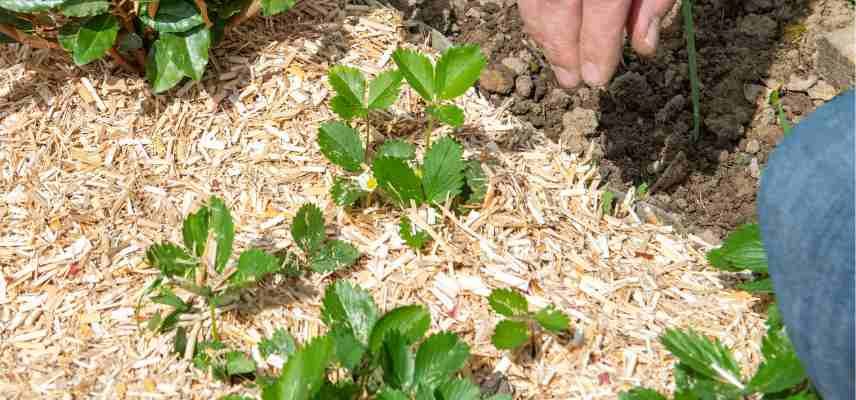
Miscanthus mulch
Planting mats
Also known as biodegradable mulch fabrics, they are often less suitable for large areas like strawberry fields, given their price. However, they offer a technical and sustainable solution, designed for long-term mulching with no maintenance and no plastic.
- Their effect on soil moisture : they effectively block evaporation while allowing water and air to circulate. The soil remains cooler, especially in summer. These fabrics also drastically reduce watering needs for strawberry plants.
- Their drawbacks regarding diseases/pests: very little negative impact – by limiting soil splashing, these felts even reduce the risk of strawberries being contaminated by soil fungi. They attract few pests.
- Minor drawbacks: their cost is higher, especially for 100% natural versions. Proper installation is required from the start (cutting, fixing). Some products are falsely labelled as “biodegradable” (always check certifications).
Quantity to use and mulch renewal
Install the fabric cut to the size of the ranks or young plants, secured to the soil with staples. Lifespan: 1 to 3 years depending on the material.
⊕ Our opinion: felts are ideal for those who want clean, long-lasting, maintenance-free mulching. They’re practical in urban settings for limited containers or small vegetable plots, where the higher cost is offset by ease of use.
→ Learn more in our articles: How to install biodegradable mulch fabric? and Mulch fabrics: pros and cons
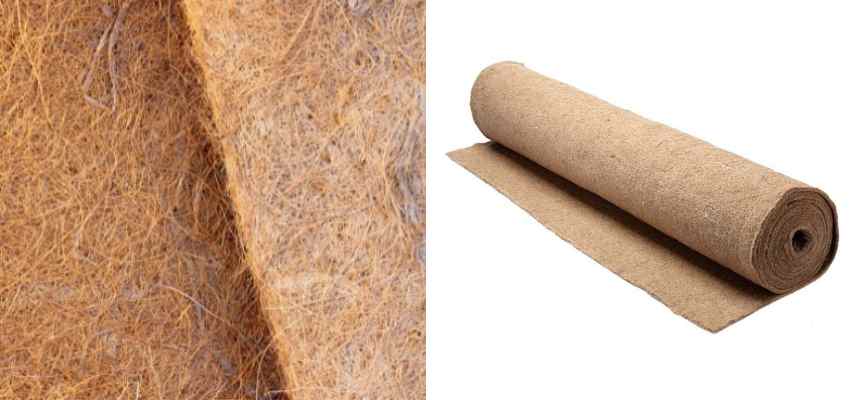
Find out more...
- Discover our full range of vegetable garden mulches in our online shop!
- Subscribe!
- Contents
































Comments